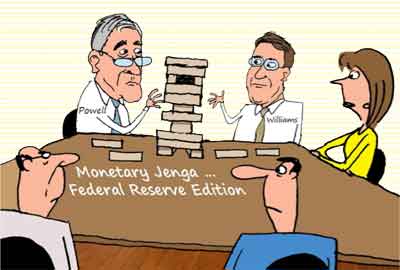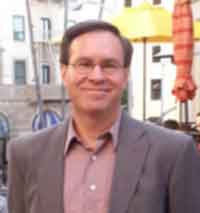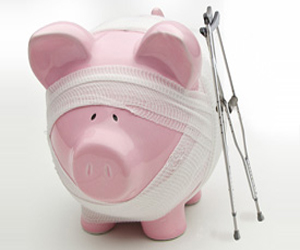What is the Fed's Game Plan
Chris Temple
 We have all become accustomed to a world in which central banks—led by our own Federal Reserve—have seen as their first (if usually unacknowledged) role the fostering of asset bubbles. As recently as December Chairman Powell did somewhat acknowledge that, as I discussed at the time. We have all become accustomed to a world in which central banks—led by our own Federal Reserve—have seen as their first (if usually unacknowledged) role the fostering of asset bubbles. As recently as December Chairman Powell did somewhat acknowledge that, as I discussed at the time.
But things are different now. As I have also recently explained, it is a bigger imperative to try and at least put some of the inflation toothpaste back in the tube. That is the political reality for a Fed which has recently become more political than ever.
Just as much as charts of the Nasdaq or the dollar, Powell and his comrades have their eye on the one below: the decline for going on a year now in consumer confidence, thanks to that “transitory” inflation.
Thus, the markets have increasingly been pricing in far more in the way of tightening in the Fed’s looming new game of “Monetary Jenga” than most of us thought likely even a couple months ago. Contrary even to my own prognostications of late last year, we have yet to see the acceleration
in year-over-year price increases peak. Indeed, the week just past gave us yet another new high water mark for this cycle: a fresh 40-plus year high of a 7.5% Y-O-Y C.P.I.
Following this, St. Louis Fed President Jim Bullard opined that he wants a full 100 basis points of interest rate increases by July. He was not the first Fed President or Governor to suggest such a thing in the recent past. Yet a
few of his comrades quickly pushed back against this. And frankly, these mixed messages and seeming on-again, off-again hesitancy on the Fed’s part to forcefully rein in the runway inflation it created was as responsible as anything for the continued swoon for the riskiest/most overpriced stocks at week’s end
Markets have priced in a better-than-even chance of an initial so-called “shock and awe” 50 basis point rate hike by the Fed next month; something the Bank of England just came within one vote of doing at its own policy meeting, settling instead for the second 25-basis point hike of its inflation fighting foray. Elsewhere, at its own latest meeting, the European Central Bank—and notably, its real dingbat of a president, Christine Lagarde—seemed as if its own denial of inflation might finally be ending.
And then we have the week- ending development at left: an impromptu closed meeting of the Fed’s Board of Governors that was just scheduled for Monday. As you can imagine, that has all of us Fed watchers rather animated. Not since the early Volcker years, as I recall, has the Fed acted outside of regularly scheduled meetings. Not since 2000 has it moved by anything more than 25 basis points in either direction.
It could be that Joliet Jay simply wants to regain control of the narrative among his own people in The Eccles Building. It’s fraying nerves even more that the Federal Open Mouth Committee isn’t reading from the same playbook. Or maybe we will get some policy action word imminently (which, I.M.O.—if one comes at all—would more likely be that the Fed is now stopping its asset purchases; I’ll explain why this has become critical in recent days a bit further below.)
But back to the nature of the first rate hike, whenever it comes: At this point, the Fed and Powell have all kinds of room to move more aggressively. And frankly, this is something that Joliet Jay I believe wants to do; and knows he needs to do to keep faith with the nitwit who reappointed him...and to
begin to restore the Fed’s own frazzled inflation- fighting credentials.
The biggest risk the Fed had in moving “aggressively” initially was that the dollar was starting to break out more notably. But with the BoE and ECB likewise more hawkish in their own ways now, that has taken the starch right back out of the greenback (though the dollar did firm at week’s end anew, due to the risk-off attitude on Wall Street and the Biden Administration’s pining for a conflict with Russia.)
In short, Powell has a “freebie” of sorts coming up, all else equal. There is a lot for him to gain in acting as if he is as serious about inflation as he intimated in his last press conference; especially when such a thing in reality will “shock” few. A bigger move will allow the Fed to front-load tightening just a bit in case there are reasons later why the Fed would see fit to pause. There seems pretty much nothing to lose; indeed, if he/the Fed wimp out and only raise rates a quarter point, the bond market will probably rebel...and hot commodity prices in some ways will become more so.
Also later, we’ll have to figure out
(hopefully with some meaningful guidance
from Powell and Company) how the Fed
intends to keep the newly-plunging yield
curve from inverting as it begins whatever
series of rate hikes we are in store for. One of
his comments that most spooked the markets
during his last press conference (when, if you
recall, stocks went from rallying after the
“official” F.O.M.C. release, but then abruptly
turned tail) was when Powell said the Fed needs to move to a "substantially less accommodative policy." And while Powell said this process needs to be “orderly and predictable” his seeming to suggest that the balance sheet will be trimmed significantly also caught some folks’ attention.
That, of course, will be a necessity if the Fed determines it needs to raise short-term rates near the upper end of the most hawkish forecasts: back to about the 1.75% area or so they were at before the Plannedemic. So I speculate that the “emergency meeting” Monday is most likely to be for the purpose of moving longer-yields somewhat higher still so that the curve does NOT soon invert. The Fed will accomplish this by announcing that the last month of bond purchases has been done away with and that it will be unwinding its balance sheet imminently.
Make no mistake: Even with a 50-basis point federal funds hike and end to new money printing, the Fed’s actions will still be more Schlock and “Haw!” Real interest rates will still be DEEPLY negative. In fact, when you think about it, they will be MORE negative after this (presumed by me) coming half-point hike than they were thought to be in for when the Fed indicated in December it
was finally going to do something. But I guess in relative terms, this will get some folks’ attention; and, the Fed hopes, buy it both time and a bit of its lost credibility.
The Fed is still going to need a lot of help from both circumstances and policy, even as it tries to undo the HUGE hole it has dug for itself where basic math (i.e.—reckless inflationary money printing) goes. There’s a reason why in so many places the lingering Big Brotherism of the Plannedemic is crumbling; one beyond the hunger for liberty lost.
And that is, policy makers (especially Sleepy Joe Biden and the Democrat Party, under the gun for high inflation deservedly or not) MUST find ways to rein in soaring costs. They have talked
themselves into the notion (since, as I have said many a time, attacking the Fed institutionally and for its financial alchemy is off limits) that the nasty Wuhan virus, lockdowns and such have been the proximate cause of shortages and rising prices.
So now we’re going to see an attempt to reopen everything; and, the story will go, watch all these various prices tumble back down. In some areas that will help. But by and large, this straw man also will prove anew politicians’ imbecility. Generally speaking, commodity prices are rising due to years’ worth of underinvestment, HORRID planning as I have explained incessantly, and etc. (NOTE: In the new issue for Members only following on the heels of this commentary, I’ll discuss this specifically in the context of energy prices; and also be providing updates on numerous of our recommendations to boot.)
In other areas, the move away from globalization will exacerbate things, too; especially with (again!) all these new carbon taxes increasing the cost of sending things to the other side of the world. Don’t hold your breath waiting for soaring inflation to reverse dramatically; many supply chains, availability of many goods from overseas, etc. will remain intractable problems.
It will be GREAT to see more and more of the insanity of the last two years finally done away with; so I am all for getting rid of all this Plannedemic nonsense whatever the real and imagined rationale. But it will be interesting to see how markets react later when (though I do still think some minor moderation will come) economies are much more “open” yet inflation still proves difficult to tame.
For present purposes, as always, if whatever surprise does (or doesn’t?) come from the Fed Monday warrants any changes to our present portfolio positioning (which was looking GREAT this past week, as both our inverse ETF bets and many commodity-oriented holdings were almost all rising together) Members will be notified immediately.
If you are NOT presently a Member, VISIT ME HERE.

Chris' more than three-decade career in various areas of the financial services industry started at an unusually tender age. Fresh out of high school, and while attending business-oriented college classes in his hometown of Binghamton, New York, Chris was recruited by a local financial planning firm. In the fall of 1979, he obtained his licensing in the insurance industry in New York. Just a few months later, he earned licensure with the National Association of Securities Dealers, or N.A.S.D., to market investment securities through his firm. In the ensuing years, Temple earned a variety of awards and professional designations relative to his expertise -- and sales -- in the areas of financial and estate planning.
Chris quickly rose through the ranks with his firm, becoming a top salesman. He was instrumental in helping his company expand throughout New York and northern Pennsylvania, opening several new offices. Particularly noteworthy is that, at just 20 years of age, he was asked by his firm to become a registered principal, and manage the day-to-day affairs of the firm's brokerage arm. Upon completion of the required training and testing, Temple became a general securities principal, was put in charge of the securities division and was responsible for managing several dozen other licensed representatives... almost all of whom were old enough to be his parents!
gainspainscapital.com
| 



